The Neue Schule Verbindend was developed by bitting expert and founder of Neue Schule, Heather Hyde.
“This bit is usually sourced by riders when a more advanced outline is required,” says Heather. “The 20 degree-angled Neue Schule Tranz lozenge may help stimulate more feel in the centre of the tongue, enabling a more precise aid to be given by the riders.
“The angle may also help the rider achieve a better connection without desensitising the tongue. The mouthpiece has been designed to avoid squeezing the tongue’s sensitive outer edges or forcing them on to the teeth.
“The lozenge, combined with the bit’s curved arms, helps to connect the pressure points required to encourage the horse to soften and relax through the jaw and topline.
“Another aim of the Verbindend is to give more lift from the horse’s shoulder and enhance the bend for lateral work. Customers have told me that the Verbindend has eradicated many long-term tongue evasions.”
The UK lorinery company Neue Schule has been involved in bitting design and development for more than 20 years.
“With a focused understanding and appreciation of the need to create a new school of bit designs, one developed to reflect the equine mouth and its conformation for the many different horse mouth types, a new generation of bitting began,” explains bitting expert, BETA field officer and lorinery consultant Tricia Nassau-Williams. “The Neue Schule range has its foundation in bits that are unique in their detail to accommodate the horse’s individual mouth type, while also incorporating modern bitting material that will aid the success of their designs.
“Most importantly, regardless of the level of work or the discipline being undertaken, their bits are an acknowledgement of a considered design approach to providing the rider with the tools and so potential to communicate with their horses in harmony and with understanding. Backed by research and analysis that is then applied to their designs, this underlines the Neue Schule approach to lorinery.”
The Verbindend mouthpiece is available as a loose ring, bradoon and D cheek snaffle, as well as a lever bit, the universal.

Neue Schule Verbindend | GS Equestrian
The loose ring version of this bit is available in seven sizes from GS Equestrian. It is dressage legal.
The Verbindend mouthpiece
This innovative double jointed mouthpiece offers no pressure downwards on to the tongue. As the rein contact is taken up, the mouthpiece forms a square shape in the mouth that provides a channel through which the horse’s tongue can lie. This in turn provides the horse with greater comfort, allowing him to move forwards into the contact while being lighter in his shoulder.
When the rider releases this bit, or the horse relaxes into a soft contact, the bit’s mouthpiece will move up into a comfortable position that encourages a relaxed tongue, jaw and way of going. The mouthpiece works on less tongue pressure and more on the lower jaw.
The mouthpiece is made from a neutral tasting copper alloy called Solax, which warms quickly to the horse’s body temperature encouraging the bit’s acceptance. With its high copper content, it is a softer metal providing a gentler consequence should the bit make contact with the horse’s teeth. Salox is nickel-free. The bit’s rings to which the mouthpiece attaches, are generally made from stainless steel.
Which types of horse the bit best suits
Tricia says: “It is useful for horses that can ‘fix’ onto one rein, bring their tongue out or draw it back over the bit, be resistant to the contact or are inclined to lean onto the rider’s hands or be heavy on the forehand.”
The Neue Schule Verbindend can:
• Encourage clarity of the aids, encouraging a true outline with freedom through the shoulder, promoting the horse’s self-carriage and potential for cadence
• Enhance the horse’s bend for lateral and small circles
• Remove tongue evasions by creating greater comfort via the channel for the tongue to lie in, allowing the horse to soften and relax through the jaw
• Help to establish a lighter, softer way of going
• Be used as a bridoon, with its 12mm mouthpiece thickness and small 55mm diameter rings, combined with a Weymouth as a double bridle
• Be helpful for use on a small headed ponies, being available in a 12mm mouthpiece thickness with 65mm diameter rings
• Be useful for some horses where the option of a 12mm thick mouthpiece and the wider 70mm diameter rings aids elevation of the shoulders and gives more room in the mouth than a thicker mouthpiece
• Help horses that are heavy on the forehand as this bit focuses the rider’s aids through the reins
• Be a useful mouthpiece for those who wish to achieve a lift through their horse’s forehand
• Suit horses who are tense, busy-mouthed, heavy or evading the rider’s aids
The Neue Schule Verbindend snaffle design is legal for both BD and FEI dressage, but do check the different class rules for the required mouthpiece diameters and cheek designs to make sure that they meet the required competition rules.

Neue Schule Verbindend | GS Equestrian
The loose ring version of this bit is available in seven sizes from GS Equestrian. It is dressage legal.
Types of bit with Neue Schule Verbindend mouthpiece
Tricia explains some of the difference variations of the Neue Schule Verbindend:
- Loose ring snaffle – a basic go-to bitting group for horse owners, the snaffle has a direct line of contact from the bit through the reins to the rider’s hands. The general action is an upward one as it has no poll pressure or lever action. The contact points in which it lies across the mouth will vary with the position of the horse’s head and neck. The loose ring allows more freedom of movement of the bit’s mouthpiece upon the tongue, affording more play and enabling the horse to position the mouthpiece where they feel it is best. It can also be useful for horses that are inclined to be heavy in the hand or take hold of the bit. Dressage legal.
- D cheek – D cheek bits are helpful for providing greater directional guidance as the D side sections above and below the mouthpiece provide a flat surface against the side of the mouth, which aids turning especially when in faster work. The D cheek also helps keep the mouthpiece central in the mouth and prevents it from being pulled from one side to the other. The D cheek can be useful for faster work, such as the showjumper requiring tight turns, and of benefit for dressage, where accuracy and clear shoulder aids are essential. Also a useful bit for novice horses or riders. Dressage legal.
- American D Lite: The American D has its side hinges positioned up and away from the corners of the horse’s mouth. This helps to lessen any possibility of the lips being pinched by the joints. Dressage legal.
- Universal: The Universal is a useful bit to help reduce resistance when asking for a downward transition or stride adjustability between fences. With several rein attachment options, it can be a handy step up from a snaffle when additional control is required. This is a versatile bit for a range of disciplines, although it is NOT dressage legal. It provides lift though the shoulder but with the Verbindend mouthpiece, it can do so while still providing tongue comfort and allowing the horse to soften and relax through his jaw. The side cheeks of the Universal provide offer extra control and enhanced turning.
Rein attachment options for a Neue Schule Verbindend Universal
• One rein attached to the large ring (snaffle action).
• One attached to the bottom ring (lever action).
• Two reins with one attached to each ring.
• The fitting of pelham roundings for use of only one rein with two attachment points.
Roundings: these can be fitted so that only one rein needs to be attached. However, it is sound equitation to learn to ride competently with two reins for greater clarity of the aids.
Curb strap: a leather curb jaw strap can be fitted to provide additional control. This is attached to the top ring and will pass behind the jaw, higher up than the curb groove where a curb chain would lie. This should be fitted so that it acts when the bits shanks are tilted to an angle of 45 degrees from the point of rest. The curb straps are available from Neue Schule suppliers.
Bit guards: rubber bit guards can be fitted to prevent pinching of the lips. Most importantly, make sure that you go up a size in the bit to allow space for these. Also that you go down a size if you remove them.
Fitting
Tricia explains: “Firstly, get the correct height of the bit by adjusting the bridle’s cheekpieces so that a joined mouthpiece just crinkles the corners of the mouth (a straight bar bit sits neatly into them with no crinkles). This can vary depending upon how thick and fleshy the lips are, as the tension placed upon them will vary depending upon this. Make sure the bit is not making contact with the horse’s teeth.
“Having found the correct height of the bit, then assess the width. Check this from the ground stood in front of the horse with a gentle rein tension applied to the ends of the bit.
“With a loose ring bit ensure enough space so that the horse’s lips are clear from the hole through which the loose ring passes so as to prevent pinching. Well-made loose ring bits will have a slightly bevelled edge to help prevent this.
“When fitting a fixed cheek, the horse’s lips should almost touch the sides to make sure that the bit will not slip adversely though the mouth. However, some space must be left so that the bit does not punch or bruise the lips. Look for just enough space to place the end of your little finger between the lip and bit’s cheek. Fit the bit when stood still, but be sure to reassess it again once you have ridden to be confident that rein contact has not changed the bit’s fit.
“The correct width and height adjustment of a bit is critical to its successful use and function as well as being horse welfare issue. Always seek the service of a qualified bit and bridle fitter if you are unsure.”
You might also like:

Does your bit fit? How to measure your horse’s mouth size

Choosing the right bit: would a hanging cheek snaffle suit my horse?

Choosing the right bit: would a Dutch gag suit my horse?

Subscribe to Horse & Hound this spring for great savings
Horse & Hound magazine, out every Thursday, is packed with all the latest news and reports, as well as interviews, specials, nostalgia, vet and training advice. Find how you can enjoy the magazine delivered to your door every week, plus options to upgrade your subscription to access our online service that brings you breaking news and reports as well as other benefits.





